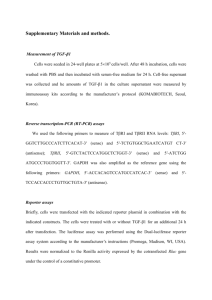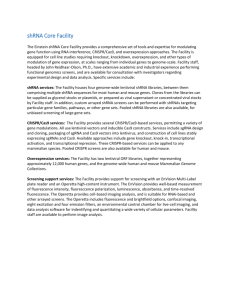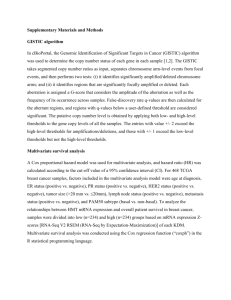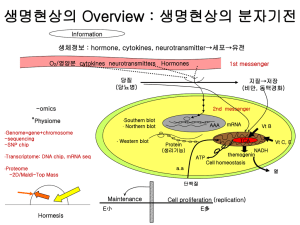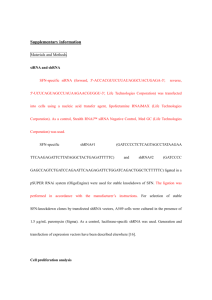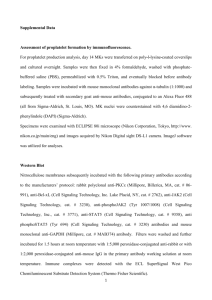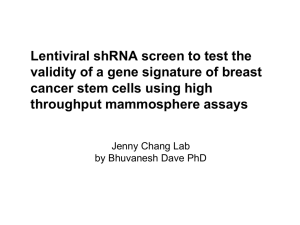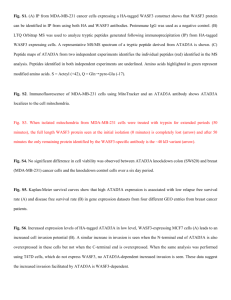Supplementary Information (doc 55K)
advertisement
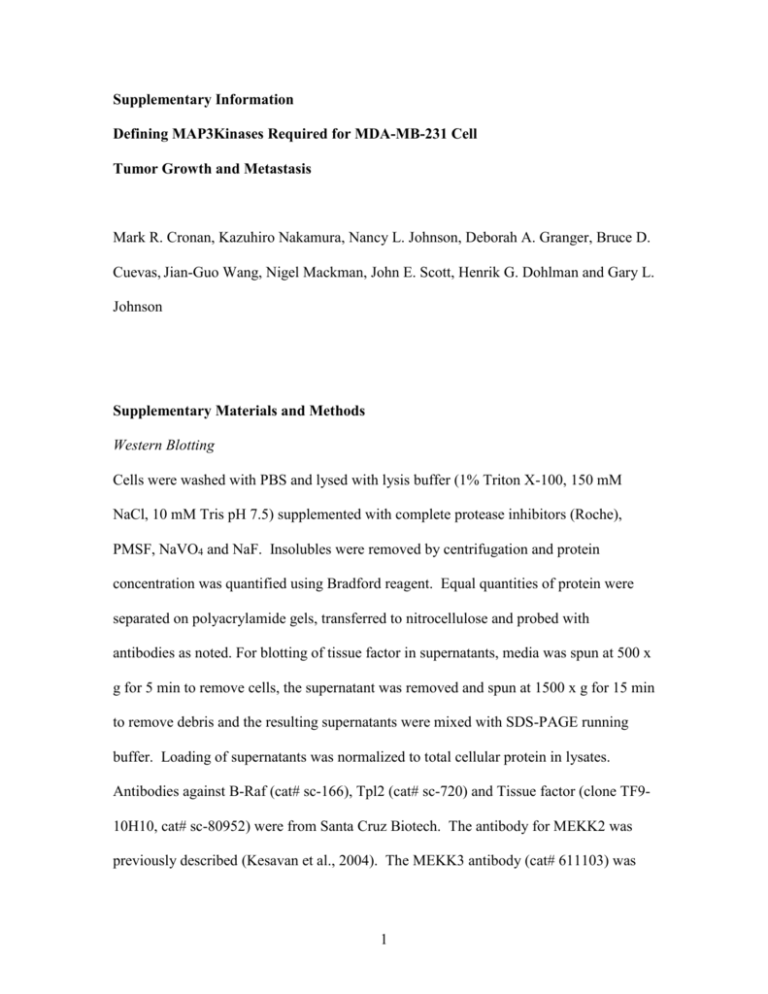
Supplementary Information Defining MAP3Kinases Required for MDA-MB-231 Cell Tumor Growth and Metastasis Mark R. Cronan, Kazuhiro Nakamura, Nancy L. Johnson, Deborah A. Granger, Bruce D. Cuevas, Jian-Guo Wang, Nigel Mackman, John E. Scott, Henrik G. Dohlman and Gary L. Johnson Supplementary Materials and Methods Western Blotting Cells were washed with PBS and lysed with lysis buffer (1% Triton X-100, 150 mM NaCl, 10 mM Tris pH 7.5) supplemented with complete protease inhibitors (Roche), PMSF, NaVO4 and NaF. Insolubles were removed by centrifugation and protein concentration was quantified using Bradford reagent. Equal quantities of protein were separated on polyacrylamide gels, transferred to nitrocellulose and probed with antibodies as noted. For blotting of tissue factor in supernatants, media was spun at 500 x g for 5 min to remove cells, the supernatant was removed and spun at 1500 x g for 15 min to remove debris and the resulting supernatants were mixed with SDS-PAGE running buffer. Loading of supernatants was normalized to total cellular protein in lysates. Antibodies against B-Raf (cat# sc-166), Tpl2 (cat# sc-720) and Tissue factor (clone TF910H10, cat# sc-80952) were from Santa Cruz Biotech. The antibody for MEKK2 was previously described (Kesavan et al., 2004). The MEKK3 antibody (cat# 611103) was 1 from BD Transduction labs. TAK1 (cat# 4505), Src family phospho-Y416 (cat# 2101), EGFR phospho-Y1068 (clone D7A5, cat# 3777), phospho-ERK1/2 (clone D13.D14.4E, cat# 4370), phospho-JNK1/2 (clone 81E11, cat# 4668) and phospho-p38 (cat# 9211) antibodies were from Cell Signaling. The ERK5 (cat# E1523), -Tubulin (GTU-88, cat# T6557) and actin (AC-40, cat# A3853) antibodies were from Sigma. siRNA screening of MAPK pathway members alone and with MAPK inhibitors siGENOME pooled siRNAs for the genes of interest were obtained from Dharmacom, Thermo Scientific. The assay was performed in either 96- or 384-well clear bottom plates. Prior to the assay, reverse transfection was optimized for each cell line using Dharmafect transfection reagent and siRNAs for GAPDH (negative control), and ubiquitin B (UBB) as a positive control. A 40 l (96 well) or 10 l (384 well) mixture of Dharmafect and siRNA was plated into each well by a multi-channel pipette and then followed by adding 160 l (96 well) or 40 l (384 well) of cell suspension using a microplate dispenser. The final assay volume was 200 l (96 well) or 50 l (384 well) with a dose of 25 nM siRNA. Appropriate drug doses were determined to obtain 30% growth inhibition with the drug alone. The assay was performed in triplicate with each plate having quadrupled (96 well) or octupled (384 well) positive control UBB siRNA and negative control GAPDH siRNA transfected cells. After 96h incubation at 37°C with 5 % CO2, the number of viable cells in each well was determined by a luminescence viability assay (CellTiter-glo, Promega) with a Pherastar microplate reader (BMG Labtech). The % growth inhibition was calculated against the averages of positive and negative controls (% growth inhibition = 100 x (1 - [raw value - σp]/[σn - σp], where σp and σn are averages of raw values for the positive and negative controls, respectively. 2 Each median in triplicate was used as a representative of % growth inhibition. Median and standard deviation (SD) of all the siRNAs screened in the presence of drug was used to draw a line for ± 1SD in the figures. Immunofluorescent Analysis of phospho-ERK1/2 and TUNEL Assay MDA-MB-231 cells were plated in 96 well imaging plates (Grenier) and serum starved overnight. After overnight starvation, cells were fixed with 3% paraformaldehyde/sucrose, permeablized with 0.2% Triton X-100 and blocked with 10% goat serum. After blocking, cells were incubated overnight with phospho-ERK1/2 antibodies (clone D13.D14.4E, Cell Signaling). Cells were washed and incubated with Alexa 555 secondary (Invitrogen), DAPI and Alexa 488-phalloidin (Invitrogen) for 1 hr. Cells were imaged using a 20x objective on a BD Pathway microscope. Tumors were snap frozen, cryosectioned at 6 m and fixed in 4% paraformaldehyde for 15 min. TUNEL assays were performed using the In Situ Death Detection Kit per manufacturers protocol (Roche #12156792). Control and MLK3 shRNA cell lines were grown for 3 days in 96 well imaging plates (Grenier). Cells were fixed and fragmented DNA was visualized by TUNEL assay using the In Situ Cell Death Detection Kit (Roche) according to the manufacturer’s protocol. Nuclear morphology Control and MLK3 shRNA cell lines were grown on coverslips for 3 days. Cells were fixed and permeabilized as for phospho-ERK1/2 and stained with DAPI and Alexa-555 phalloidin (Invitrogen). Cells were imaged with a 40x objective on a Zeiss Axiovert 200; for each slide the nuclear morphology of ~200 cells was scored. 3 Propidium Iodide staining and Flow Cytometry Subconfluent, asynchronously growing cells were trysinized and counted. 3 x 106 cells were washed 2 times with PBS. Cells were fixed in 70% ethanol overnight at 4C. Fixed cells were stained by adding cells to a solution of 0.1% triton X-100 containing 20 g/mL propidium iodide and 200 g/mg DNase free Rnase and incubating at 37C for 20 minutes. Cells were analyzed by flow cytometry (CyAn, Dako) and 2N and 4N peaks were defined within each experiment and used for all samples within an experiment. Multianalyte secreted factor profiles 8 x 104 MDA-MB-231 cells were plated in 6 well plates and allowed to attach overnight. After attachment, media was changed to serum free DMEM and cells were incubated for 3 days. Media was removed and spun to remove cellular debris and frozen at -80C. Supernatant samples were sent to Rules Based Medicine (Austin, TX) for multiplex cytokine analysis using the HumanMAP array. Measurement of Tissue Factor antigen and activity MDA-MB-231 control (pLKO) or MEKK2 shRNA knockdown cells were plated and grown in 12-well plates. Growth medium (10% FBS) was collected when the cells were 90% confluent. Fresh cell culture medium was spun down at 500g for 5 min, followed by 1500g for 15 min. The supernatant containing microparticles (MPs) were saved and frozen at -20°C. Cell monolayers were scraped, sonicated and frozen in PBS at -20°C. Levels of human TF antigen in cell culture medium were measured using IMUBIND Tissue Factor ELISA Kit (American Diagnostica, No. 845). Microparticle TF activity in cell culture medium or TF activity in cell lysate was measured using a two-stage chromogenic assay as described before (Khorana et al., 2008). Briefly, MPs were spun 4 down at 20,000 ×g for 15 min and washed twice with PBS. The MP suspension samples or cell lysates were incubated with human factor VIIa and human factor X in the presence of either mouse anti-human TF blocking antibody (HTF-1) or the isotype IgG control at 37°C for 30 min or 15 min, respectively. Total protein concentration of the cell lysate was measured using a Dc protein Assay kit (Bio-Rad). Levels of cellular TF activity, TF antigen or MP TF activity in the medium was normalized by the total protein concentration. Real time PCR of lymph nodes for presence of tumor cells and MAP3K knock down Total RNA was isolated from RNALater-stabilized murine lymph nodes using the Micro RNeasy Kit (Qiagen). cDNA from each knockdown (lymph nodes containing MAP3K shRNA MDA-MB-231 cells) and its corresponding control samples (lymph nodes containing control MDA-MB-231) were generated using the High Capacity Reverse Transcription Kit (Applied Biosystems). Real-time quantitative PCR was done in triplicate for each lymph node sample to determine message levels of the human MAP3K and B-actin. A standard curve was generated from the control samples by graphing the average threshold values (CT) for the human MAP3K versus those for human b-actin. The corresponding knockdown samples were graphed similarly. All TaqMan assays (Applied Biosystems) used in these experiments were determined empirically to detect only human and not murine cDNA. Supplemental References Kesavan K, Lobel-Rice K, Sun W, Lapadat R, Webb S, Johnson GL and Garrington TP. (2004). J Cell Physiol, 199, 140-8. Khorana AA, Francis CW, Menzies KE, Wang JG, Hyrien O, Hathcock J, Mackman N and Taubman MB. (2008). J Thromb Haemost, 6, 1983-5. 5 Supplementary Figure Legends Figure S1 siRNA screen of MAPK signaling network kinases for affects on growth of MDA-MB-231 cells. (a-c) Synthetic lethal siRNA screen targeting the MAPK signaling network in MDA-MB-231 cells. Twenty-five nmol siRNA for 10 MAPKs, 7 MAP2Ks, 21 MAP3Ks were reverse transfected into MDA-MB-231 cells in the presence or absence of 5 M U0126 (MEK1/2 inhibitor), 15 M SP600125 (JNK inhibitor), or 30 M SB203580 (p38 inhibitor). After 4 days incubation, cell viability was measured by Cell TiterGlo. Percent growth inhibition of each siRNA was calculated as outlined in materials and methods as the median of each triplicate and plotted. Upper and lower one standard deviation (SD) lines are drawn in blue as the median ± 1 SD of all the siRNA screen data in the presence of each compound. (d) MDA-MB-231 cells were grown in the presence or absence of 10 M U0126, 10 or 30 M SP600125, 10 mM SB203580 or DMSO as control. Viability was assayed daily for four days after addition of inhibitor. Data is mean ± SEM of quadruplicate wells for each condition. Figure S2 Analysis of shRNA knockdown of targeted MAP3Ks. (A, B, C, D and E) Western blots demonstrating knockdown of specific MAP3Ks by different shRNAs in MDA-MB-231 cells. -Tubulin was used as a loading control. For each MAP3K shRNA, the TRCN sequence number is listed and the percentage knockdown as determined by densitometry of the MAP3K relative to control is indicated below the blots. MAP3Ks targeted are (A) B-Raf. (B) Tpl2. (C) MEKK3. (D) TAK1. (E) MEKK2. (F) Real time PCR demonstrating knockdown of MLK3 by TRCN shRNAs. For MLK3 realtime PCR, RNA levels were normalized to -actin signal and MAP3K RNA levels 6 were quantitated relative to control cells. Data presented are mean range. (G-L) MAP3K knockdown was assessed in lymph node metastases. To confirm continued knockdown of each MAP3K, standard curves were generated from control lymph node metastases by graphing the cycles to threshold for -actin against cycles to threshold for the MAP3K. Cycles to threshold from MAP3K shRNA lymph node metastases were plotted as points on the same graph. Continued knockdown of the MAP3K in metastases resulted in the MAP3K shRNA points appearing above the standard curve. Knockdown was assessed in metastases from cell lines having shRNA knock down for (G) B-Raf. (H) Tpl2. (I) MEKK3. (J) TAK1. (K) MEKK2. (L) MLK3. Figure S3 MEKK2 shRNAs inhibit tumor growth and ERK5 activation in response to EGF. (A) Knockdown of MEKK2 with a second shRNA results in reduced ERK5 activation in response to EGF. Lysates from EGF stimulated control and MEKK2 shRNA 2 knockdown cell lines were blotted for ERK5, phospho-ERK1/2, phospho-JNK or for -Tubulin as a loading control. (B) MEKK2 knockdown inhibits ERK5 activation by EGF in SUM159 and Hs578t cells. SUM159 and Hs578t cells were stimulated with 10 ng/mL EGF for the indicated times and blotted for ERK5. Long exposures were performed to detect the slower moving phosphorylated form of ERK5, while shorter exposures were used to demonstrate equal loading of protein. (C and D) MEKK2 knockdown inhibits tumor growth and metastasis. Control cell lines and cell lines expressing MEKK2 shRNA 1 and shRNA 2 were injected into the mammary fat pad of SCID mice. (C) Mice injected with MEKK2 shRNAs show decreased tumor size relative to control. Quantitation of tumor weight at time of sacrifice. Bars represent mean SEM 7 of n = 8 (Control and MEKK2 shRNA 2) or n = 7 (MEKK2 shRNA 1), * p <0.02, ** p< 0.005 by unpaired t-test. (D) Tumors formed from a second set of MEKK2 shRNA cell lines injections had diminished metastasis. Number of mice determined to be metastasis positive by BLI at time of sacrifice (59 days). p-values for pooled control mice vs. pooled MEKK2 shRNA mice were calculated by Fisher’s exact test. (E) MEKK2 knockdown causes increased apoptosis of MDA-MB-231 xenografts. Sized matched control and shRNA MEKK2 tumors were analyzed for apoptosis by TUNEL assay. (F) MEKK2 knockdown does not alter cell growth in vitro. Control and MEKK2 knockdown cell lines were plated in 96 well plates and viability was assessed by ATP viability assay. Figure S4 MLK3 knockdown inhibits growth of multiple cancer lines in vitro and tumor growth and metastasis at multiple sites of implantation. (A) Growth of control and MLK3 shRNA SUM159 cell lines over 4 days as measured using an ATP based viability assay. Individual measurements were normalized to day 0 signal. Each data point is mean SEM of quadruplicate samples. (B) Growth of control and MLK3 shRNA Hs578t cell lines over 4 days as measured using an ATP based viability assay. Individual measurements were normalized to day 0 signal. Each data point is mean SEM of quadruplicate samples. (C) Quantitation of tumor mass from mice injected with either MLK3 shRNA 1 or MLK3 shRNA 3 cell lines. Each data point is mean SEM, n = 7 (Control) or n = 8 (MLK3 shRNA 1 and MLK3 shRNA 3), * p < 0.01 by unpaired t-test. (D and E) Cell lines with MLK3 knockdown have similarly decreased tumor growth and metastasis when implanted in the flank. Control cell lines or cell lines expressing three different MLK3 shRNAs were injected into the flanks of SCID animals. (D) Tumor 8 volume was assessed by caliper measurements at time of sacrifice in control and MLK3 shRNA cell lines. Mice injected with MLK3 shRNA cell lines show similar decreases in tumor volume as was seen in the mammary fat pad. Bars represent mean SEM, n = 6 (Control, MLK3 shRNA 2 and MLK3 shRNA 3) or n = 5 (MLK3 shRNA 1), * p <0.002 by unpaired t-test. (E) MLK3 knockdown lines have diminished metastasis from flank tumors. BLI was used to identify the number of mice that were metastasis positive at time of sacrifice (48 days post injection). p-values for pooled control mice vs. pooled MLK3 shRNA mice were calculated by Fisher’s exact test. (F) MLK3 knockdown causes increased apoptosis of MDA-MB-231 xenografts. Sized matched control and shRNA MLK3 tumors were analyzed for apoptosis by TUNEL assay. Table S1 The relative size of metastases detected by bioluminescent imaging was measured by the luminescent photon flux of each metastasis. For quantitation, images of control and knockdown metastases were taken with identical conditions at identical times after luciferin injection. The sizes of metastases for control and shRNA cell lines are presented as average metastasis luminescence and the standard deviation of the measurement and the total number of metastasis positive mice is noted. The control cohort for B-Raf shRNA 1 and TAK1 shRNA 1 are derived from the same experiment. Table S2 Multianalyte profiles of secreted proteins from control, MEKK2 shRNA and MLK3 shRNA cell lines. Cells were grown in serum free media for 3 days and supernatants were assessed for the concentration of 88 soluble factors by Rules Based Medicine. For each analyte, concentrations are normalized to total cellular protein levels 9 to control for cell growth differences. Analytes marked N.D. were below threshold of detection of the assay. 10
